So it finally happened. Coming home riding down the M1 around 70, went for an overtake and increasing speed and the engine went bang. This was followed by what sounded like shattered wine glasses rattling around inside the engine.
Instantly I knew what had happened, as I was kinda expecting it although I didn't expect it to happen so soon, just 450 miles into this rebuilt engines life.
So clutch in and free wheeled to the hard shoulder, thankfully I was able to do that safely and get onto the hard shoulder without too much fuss from other traffic around me. Then it was time to wait for the AA - made it very clear to them that I'll need a recovery home so don't be trying to fix it on the road as this engine has had it.

So I get home, and I'm instantly curious to see what's happened so I pull the cam chain cover, and as I suspected, I've spun a bearing. Although what was surprising was that the main bearing closest to the cam chain had actually come loose and had come out of it's housing and made it's way onto the cam chain sprocket and then got chewed up by the cam chain as shown in the below pic. That was the sound I must have been hearing that sounded like shattered glass.

I turn the engine over a couple of times and you can now see it from a different angle. The bearing has almost moulded itself onto the cam chain sprocket. Tried to get it off with a screwdriver but that thing is well and truly stuck on there.

Now I'm very curious to see what other damage has been done. It's very likely that the valve timing was thrown out as the bearing got caught up in the cam chain so this may have caused valve and piston damage.
So a replacement engine is now on the way. This time round I'm not going to be stripping down the replacement engine, just doing the usual service items on that and then putting it in the bike. It's an engine which has done 8000 miles so much less mileage than what this had. It also looks to be in much better condition so looking forward to getting that in there.
I don't think this experience has put me off doing engine rebuilds (only if I needed to do one) but it has taught me a lot. Sometimes doing an engine rebuild is not always the most cost effective way of fixing an engine considering you can get pretty good used engines on eBay for near enough the same cost in replacement parts when doing a rebuild.
Secondly when it comes to engine rebuilds and replacing bearings. Do NOT and I mean absolutely DO NOT ignore what the service manual says about doing serious engine damage if you get the bearing selections wrong. They aren't kidding when they say that. Also don't mismatch crankcase halves as those things are machined as a set.
So looking back, I certainly would not have taken a sledge hammer to that oil cooler to get it off the engine block. The only reason I did that was because I had snapped off the rusted bolts trying to get the oil cooler off. That's another lesson learnt too - if you suspect a bolt is way too rusted to come off normally with a socket spanner, then use an impact wrench to get it off. The hammering action of the impact wrench is far less likely to snap it off compared to the twisting force of a socket spanner. Had I used the impact wrench in the first place, I would have been able to get the oil cooler off without problems.
I then wouldn't have cracked my lower crankcase and when I got the engine apart and replaced the crankshaft I should have ordered the correctly coloured bearings for the replacement crankshaft I put in there.
Another thing - plastigauge is not massively accurate. Whilst it gives an ok estimate of clearance it's not a pin point accurate measurement of clearance. I shouldn't have relied on this for my measurement of the clearances but also - considering my crankcase halves were mismatched anyway the crankshaft would have worn the bearings in the upper and lower crankcase halves at different rates causing the spun bearing that happened yesterday.
Finally - low oil pressure is pretty serious and a flickering oil light at idle was a good warning sign that things are going to get worse.


















































